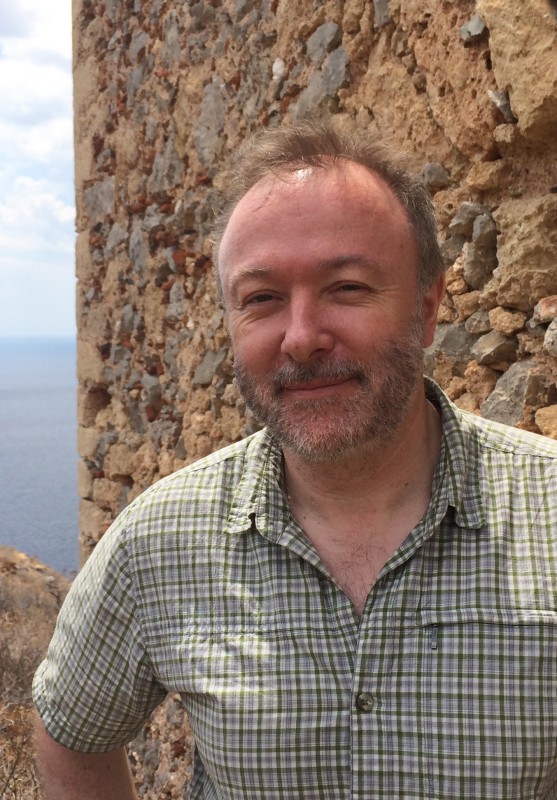Affiliation: University of Victoria

Professor Marcus Milwright is with the Department of Art History and Visual Studies at the University of Victoria; he holds his degrees from Edinburgh University and the University of Oxford (D.Phil.). His areas of specialization include the art and archaeology of the Islamic world, cross-cultural interaction in the Mediterranean in the medieval and early modern periods, crafts and labor in the Islamic Middle East, and the history of medicine. His current publications include Islamic Arts and Crafts: An Anthology (2017), The Dome of the Rock and its Umayyad Mosaic Inscriptions (2016), and An Introduction to Islamic Archaeology (2010). Professor Milwright was the AIA Ettinghausen Lecturer for 2018/2019.
Prior to the advent of mass air travel Muslims performing the pilgrimage (hajj) to the Holy Cities of Mecca and Medina were faced with long, expensive, and often physically arduous journeys by land and sea. In most cases, these routes predated the birth of Islam and had long been employed by merchant caravans, armies, and travellers. The annual movement of large numbers of Muslims along both roads and sea routes naturally brought with it significant economic considerations. Most important was the supply of foodstuffs to pilgrims although money might also be given to nomadic groups to protect caravans from banditry. Much of the financing was provided by the Muslim polities through which the main hajj routes ran, but food and other supplies were also purchased by individual pilgrims from merchants, artisans and farmers along the way. Temporary markets were sometimes established in rural areas in order to benefit from the passage of the hajj, while pilgrims might sell valuable goods en route in order to pay for the onward journey. Lastly, there is evidence for the creation of crafts devoted to the production of tokens of pilgrimage. These varied forms of economic activity have left numerous traces in the archaeological and historical records. This talk discusses that evidence with a particular focus on the route leading from Damascus to Mecca in the period from the late thirteenth to the end of the nineteenth century (the Mamluk and Ottoman sultanates). The annual passage of the hajj caravan radically transformed the extent and nature of trade in the regions bordering the road in ways that can still be seen today.
Short bibliography and/or website on lecture topic:
Suraiya Faroqhi, Pilgrims and Sultans: The Hajj under the Ottomans, 1517–1683 (London and New York: I B Tauris, 1994).
Marcus Milwright, An Introduction to Islamic Archaeology, New Edinburgh Islamic Surveys (Edinburgh: Edinburgh University Press, 2010), chapter 8 (pp. 159-73).
F. Peters, Mecca: A literary History of the Muslim Holy Land (Princeton NJ: Princeton University Press, 1994).
Andrew Petersen, Medieval and Ottoman Hajj Route in Jordan: An Archaeological and Historical Study, Levant Supplementary Series 12 (Oxford and Oakville: Oxbow Books and Council for British Research in the Levant, 2012).
Venetia Porter, ed., Hajj: Journey to the Heart of Islam (London: British Museum Press, 2012)
Venetia Porter and Liana Saif, eds, The Hajj: Collected Essays, Research Publications 193 (London: British Museum Press, 2013).
The prominent role played by writing in the visual cultures of the Islamic world is, of course, well known. Ornamental scripts adorn buildings and objects of all periods from the seventh century to the present. Writing functions in these contexts both as a carrier of meaning and as an object of aesthetic interest in its own right. There can be little doubt that the Muslim community recognized the power and visual potential of the written word from an early stage. The first monumental inscriptions appear in the 640s, a little more than a decade after the death of the Prophet Muhammad, and reach a high level of sophistication in the mosaic decoration of the Dome of the Rock in the 690s. The talk reviews this fascinating assemblage of early inscriptions, concentrating particularly on the inclusion of explicitly religious content. This content ranges from pious phrases to statements of faith and citations from the Qur’an. These inscriptions appear on rock inscriptions, documents, coins, seals, and architecture. The talk will ask how and why scripture and statements of faith were first incorporated into Islamic monumental inscriptions, comparing the strategies employed by early Muslims to those of other faith communities of the Late Antique Middle East. The talk will argue that early Muslims were influenced by the practices of each conquered region, and that this accounts for significant differences in the manner in which inscriptions are used across the Islamic empire between the seventh and the tenth centuries.
Short bibliography and/or website on lecture topic:
Alain George, The Rise of Islamic Calligraphy (London and Berkeley CA: Saqi, 2010).
Oleg Grabar, The Shape of the Holy. Early Islamic Jerusalem (Princeton NJ: Princeton University Press, 1996).
Robert Hoyland, ‘New documentary texts and the early Islamic state’, Bulletin of the School of Oriental and African Studies 69.3 (2006), pp. 395-416.
Michael Macdonald, ed., The Development of Arabic as a Written Language, Supplement to the Proceedings of the Seminar for Arabian Studies 40 (Oxford: Seminar for Arabian Studies and Archaeopress, 2010).
Marcus Milwright, The Dome of the Rock and its Umayyad Mosaic Inscriptions (Edinburgh: Edinburgh University Press, 2016).
Bilha Moor, ‘Mosque and church: Arabic inscriptions at Shivta in the early Islamic period,’ Jerusalem Studies in Arabic and Islam 40 (2013), pp. 73-141.
For many of the inscriptions discussed in the talk: http://www.islamic-awareness.org/History/Islam/Inscriptions/